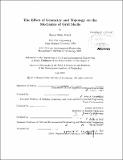The effect of geometry and topology on the mechanics of grid shells
Author(s)
Malek, Samar R. (Samar Rula)
DownloadFull printable version (23.10Mb)
Other Contributors
Massachusetts Institute of Technology. Dept. of Civil and Environmental Engineering.
Advisor
John A. Ochsendorf and Tomasz Wierzbicki.
Terms of use
Metadata
Show full item recordAbstract
The use of grid shell structures in architecture and structural engineering has risen in the past decade, yet fundamental research on the mechanics of such structures is lacking. Grid shells are long span structures comprised of a lattice of single layer members forming a curved surface. Grid shells can be made of a wide range of materials from steel to wood. They have potential to be used in readapting existing spaces or in new aesthetically pleasing structures. By studying their mechanics, engineers can be more effective at the schematic phase of design so that the potential of grid shells can be maximized. This research conducts a parametric study that varies the topology and topography of grid shells. The parametric space is framed around real-world design constraints including the grid spacing, panel shape, span-to-height ratio and the use of double curvature. In this thesis, the buckling capacity is evaluated using finite element analysis for two typical grid shell geometries: the spherical cap and the corrugated vault. First, a spherical cap is considered for which an analytical solution exists and therefore the accuracy of the numerical procedure is validated. Simple closed-form solutions are derived using the concept of the equivalent continuum and compared to the numerical models. Then, the parametric study of the spherical cap is performed including variations of the grid spacing, the span to height ratio and the panel shape (triangles and quadrilaterals). Having determined the efficiency of the computational tool the study is extended to the barrel vault. Here the new features of the analysis are the use of double curvature by introducing corrugation along the edge and the crown. By understanding the fundamental mechanical behavior of grid shells, design guidelines aimed to maximize their capacity and efficiency and intended to facilitate the discussion between architect and engineer are proposed.
Description
Thesis (Ph. D.)--Massachusetts Institute of Technology, Dept. of Civil and Environmental Engineering, 2012. Cataloged from PDF version of thesis. Includes bibliographical references (p. 128-131).
Date issued
2012Department
Massachusetts Institute of Technology. Department of Civil and Environmental EngineeringPublisher
Massachusetts Institute of Technology
Keywords
Civil and Environmental Engineering.